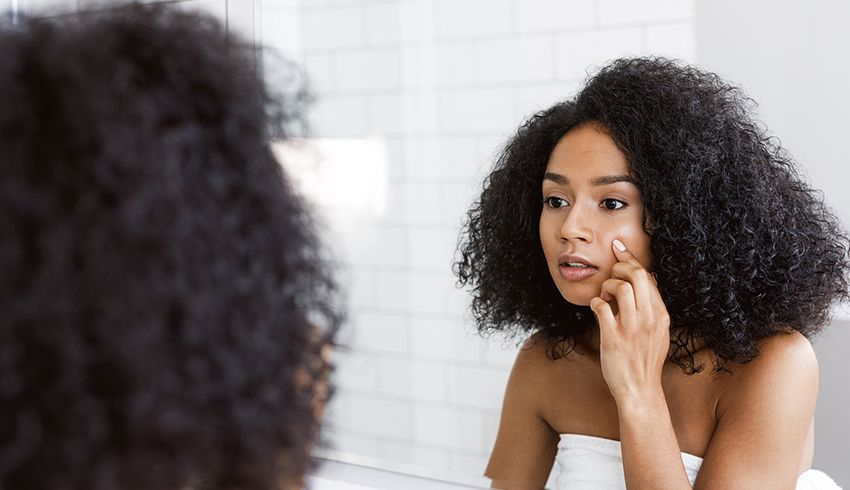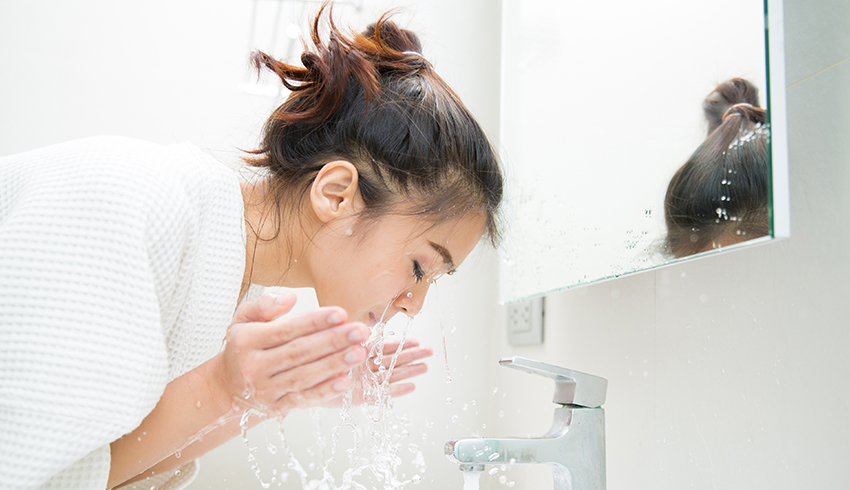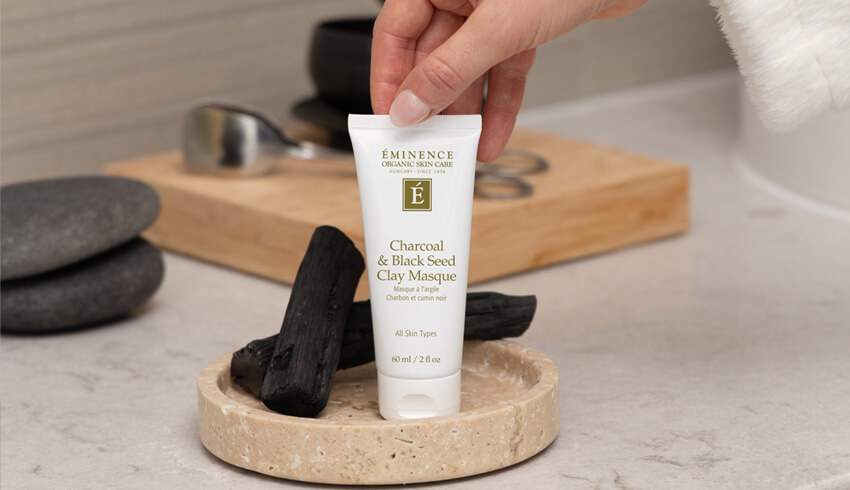
Being able to identify different types of acne is crucial when defining your skin care goals. Not only does knowing the lingo make it easier for you to choose the right home care products, it’s also helpful when developing a treatment plan with your esthetician. To ensure you’re ready to communicate your skin care concerns, learn all about the differences between pustules and papules and the best ways to treat the most common types of acne.
Basic Definitions To Understand Acne
To help navigate the world of acne, some basic definitions are a helpful place to start. While we have no doubt that you’re familiar with the words “pimple” and “pore,” below are additional phrases to help understand the different types of acne.
Hair Follicle
A hair follicle is the small cavity in the first two layers of the skin where a hair develops. A hair follicle is not a pore per se, rather the pore typically refers to the opening of the hair follicle at the surface of the skin.
Comedo
A comedo (or in plural, comedones) is the primary sign of acne and what we generally consider to be the base of a “zit.” Comedo refers to the dilated hair follicle that becomes filled with sebum, dead skin cells and bacteria.
Sebum
Sebum is the waxy, oily secretion produced by your sebaceous glands. These glands are typically connected to the hair follicle to help keep your hair and skin moisturized. Sebum is crucial for keeping the skin flexible and protected from bacteria and fungi.
Mild, Moderate & Severe Acne
These categories denote the intensity of any type of acne. Fewer than 20 whiteheads or blackheads, or 15 inflamed bumps is considered mild acne. 20 to 100 whiteheads or blackheads, or 15 to 50 inflamed bumps is considered moderate acne, and anything greater than this is considered severe acne.
Acne Vulgaris
Acne Vulgaris is the most common form of acne and what most of us think of when we picture the skin condition. Typically, acne vulgaris develops as the result of an overabundance of sebum, and/or changes in hormones. Approximately 85 percent of people between the ages of 12 and 24 will experience at least a mild case of acne vulgaris.
Non-Inflammatory & Inflammatory Acne
Acne types are considered either non-inflammatory or inflammatory. Non-inflammatory acne is visible but not painful. Inflammatory acne can be more difficult to treat, with blemishes that are often red, swollen and sensitive. Concerns like scarring, infection and pitting are more common with inflammatory acne.
Common Types Of Acne
With these definitions in mind, it is much easier to break down the most common types of acne. Each of these is a variety of comedones that present in a different way. All of these types can be a symptom of acne vulgaris, and can appear in any combination, from mild to severe acne.

Blackheads
Even if you’ve never dealt with blackheads personally, you’ve likely seen them as they are incredibly common. Blackheads are a form of acne where the comedo is open at the top, causing the accumulated sebum and dead skin cells to oxidize (darken). The only difference between a blackhead and a whitehead is that the comedo is open in a blackhead.

Blackheads may be raised slightly but can also be completely flat with the surface of the skin. They are non-inflammatory and are typically best treated with topical remedies that exfoliate and soften sebum and contain ingredients like salicylic acid. SPF is also key as sun exposure can lead to pore dilation and further blackheads.
Whiteheads
As our Eminence Organics Product Support Team explain, “Whiteheads, or closed comedones, are follicles that are filled with the same material as blackheads but have a thin layer of skin covering them. Since the air cannot reach the follicle, the material is not oxidized and remains white.”

Whiteheads are very small, raised, possibly with slight redness around the base. They are also non-inflammatory, and best treated topically with exfoliating treatments and a skin care regimen containing salicylic acid.
Pustules
Pustules are closed comedones, often yellow or white with redness at the base of the swelling. Unlike whiteheads and blackheads, pustules are an inflammatory type of acne. Alicia says: “Pustules are inflamed lesions that are pus-filled. Extracting or popping pustules at home can lead to the skin scarring.”

Pustules tend to be larger than whiteheads and are quite painful. Whereas exfoliants can improve non-inflammatory acne, you want to avoid scrubbing pustules as this can cause further irritation. To manage this type of acne, Alicia recommends visiting an esthetician and being “consistent with your skin care regimen, including washing your face (twice daily!) with a non-stripping cleanser.”
Papules
Papules are small, often sensitive, red and pink bumps. While they may look similar to whiteheads, papules are an inflammatory type of acne, meaning they are tender and sore. Papules can even turn into pustules should the comedo develop pus that pushes up towards the surface of the skin.

Salicylic acid spot treatments can be dabbed onto papules to help clear them away should you have mild breakouts. For severe papule acne breakouts, seeing an esthetician or dermatologist is recommended to perform professional extractions or treatments.
Nodules
A close relative of papules are nodules. Nodules are also red and tender, but these large, hard pimples are embedded deep under the skin. Nodules do not respond especially well to topical home treatments as they develop so deeply. Depending on whether an infection is present, nodules can take weeks to months to heal and may leave scars. Alicia notes that "visiting a spa for a facial and having a professional perform extractions is recommended, depending on your state or provincial legislation on extractions. Your esthetician will often use exfoliating products and/or steam before extractions, followed by a calming or purifying masque. Do not attempt to perform extractions at home as this can lead to angry, inflamed skin and scarring.”

Getting Rid Of Acne
While you may not be able to “get rid of your acne” per se, with continuous treatment you can absolutely reduce the frequency and severity of your pimples. Salicylic acid is a powerhouse ingredient when it comes to treating different types of acne as it deep cleans pores and exfoliates the skin. A great example of this is the encapsulated salicylic acid found in Eminence Organics Acne Advanced 3-Step Treatment System. This home care system is gentle and will not strip the skin but is still effective at drastically improving breakouts and leaving your skin looking smooth and clear.
If you think you have any (or all!) of the types of acne detailed in this article, we recommend visiting an Eminence Organics Spa Partner on a regular basis. At the spa, a licensed esthetician can confirm which types of acne you’re dealing with and ensure that you’re incorporating the correct methods of treatment. While non-inflammatory acne is easier to manage with home care and topical treatments, inflammatory acne is best treated with additional professional care. Visiting an esthetician will alleviate your concerns with treating your breakouts and ensure you have an adequate plan in place to reach your skin care goals.
What did you learn about the different types of acne? Has anything changed in how you would treat your breakouts? Let us know in the comments below. Don’t forget to join the conversation on social media.


